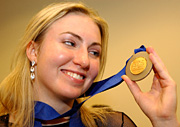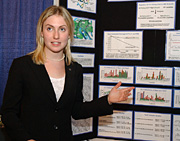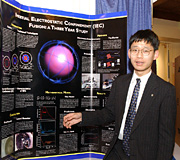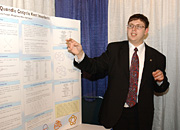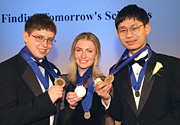 |
Top Teen Scientists Honored At Intel Science Talent Search$100,000 Top Scholarship Awarded to Jamie Elyce Rubin of Florida; Awards Total $530,000WASHINGTON, D.C., March 11, 2003 - Ten of the nation's brightest high school seniors received scholarships as high as $100,000 today at the Intel Science Talent Search (STS), America's oldest and most prestigious science competition. Projects among this year's Top 10 winners include identifying factors that contribute to the increase in cockroach allergy-induced asthma observed in inner city areas and a study that discovered a previously unidentified plateau on Venus that could lead to better understanding of the planet's formation. Jamie Rubin, 16, of Canterbury School in Fort Myers, Fla., won top honors and a $100,000 scholarship in the Intel STS, often considered the "junior Nobel Prize." Rubin identified small molecules that could be useful as targeted treatment for infections caused by Candida albicans. This yeast can cause severe infections, especially in patients with compromised immune systems such as those with AIDS or cancer. Rubin was inspired by her volunteer work with patients at Hope Hospice in her hometown. The second place prize, a $75,000 scholarship, went to Tianhui "Michael" Li, 18, of Oregon Episcopal School in Portland. Li's physics project is based on his three-year study of inertial-electrostatic confinement, a radically different and significantly less expensive way of controlling nuclear fusion than conventional methods. Li is an accomplished pianist who has performed with the Portland Symphony Orchestra. Anatoly Preygel, 17, of Montgomery Blair High School in Silver Spring, Md., won the third-place $50,000 scholarship for his study of knot theory, an area of mathematics which examines closed curves in three-dimensional space and has applications in genetic research. Preygel enjoys reading, traveling and maintaining his school Web site. "Many Intel STS finalists will go on to have distinguishing science careers, perhaps one day solving a fundamental scientific challenge or making a scientific breakthrough that helps improve people's lives," said Craig Barrett, Intel's chief executive officer. "Intel STS students, their teachers, schools and parents exemplify what the country and our businesses need -- a passion for science and math." Rounding out the top 10 winners:
The remaining 30 finalists will each receive a $5,000 scholarship and all students will receive a high-performance computer. Judging "The judging committee works to identify students with exceptional promise for future leadership and creativity in science and technology. With such a group of outstanding students, it is an arduous task to select the top 10," Yeager said. Background Science Service, a nonprofit organization whose mission is to advance the understanding and appreciation of science among people of all ages through publications and educational programs, has administered the program since its inception in 1942. Over the years, STS has recognized more than 2,000 finalists with more than $5 million in scholarships. For more information on Science Service and the Intel STS, visit www.sciserv.org. Intel's sponsorship of the Science Talent Search is part of the Intel® Innovation in Education initiative to prepare today's teachers and students for tomorrow's demands. Intel develops and supports education programs that help meet the needs of students and communities worldwide through improving science and mathematics education; improving education through the effective use of technology in classrooms; and broadening access to technology and technical careers. * Other names and brands may be claimed as the property of others. Intel is a trademark or registered trademark of Intel Corporation or its subsidiaries in the United States and other countries. * Other names and brands may be claimed as the property of others. |
Click an image to download the high-resolution version
|
